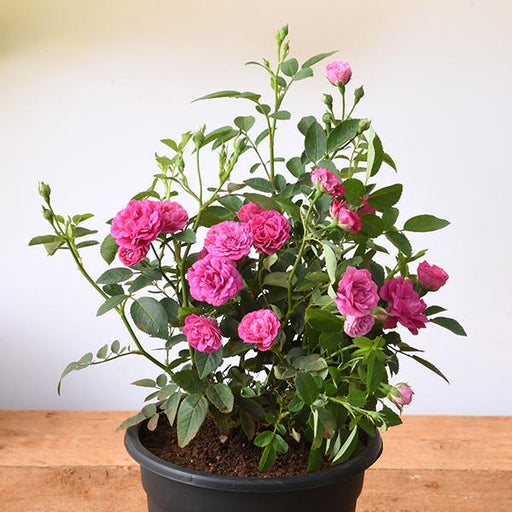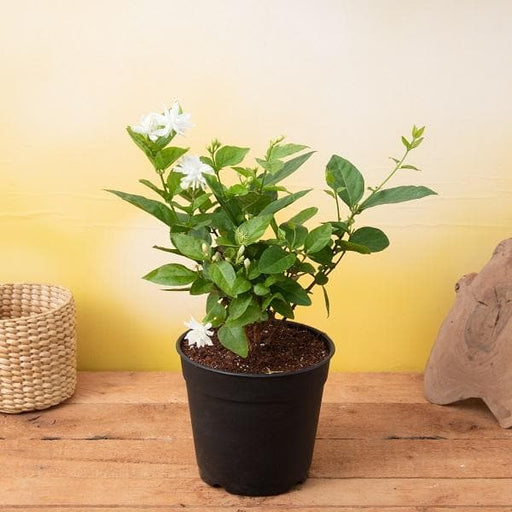
Corchorus acutangulus
(MRP Inclusive of all taxes)
- Shipping ₹79 for entire order
- Dispatch in 7 days
- Country of origin: India

(MRP Inclusive of all taxes)
 Save 29%
Save 29%
Air Purifier Money Plant with Pot The Air Purifier Money Plant, also known as Pothos or Epipremnum aureum, is a stunning indoor plant that...
View full details
 Save up to 15%
Save up to 15%
Peace Lily, Spathiphyllum - Plant The Peace Lily, scientifically known as Spathiphyllum, is a stunning houseplant celebrated for its elegant white...
View full details
 Save 25%
Save 25%
Jasminum sambac, Mogra, Arabian Jasmine - Plant Jasminum sambac, commonly known as Mogra or Arabian Jasmine, is a fragrant flowering plant...
View full details
 Save 18%
Save 18%
Combo Constituents Includes the Parijat Tree (Night-Flowering Jasmine), a culturally significant plant with fragrant flowers. Description The Pari...
View full details
 Save 25%
Save 25%
Miniature Rose, Button Rose (Any Color) - Plant The Miniature Rose, also known as the Button Rose, is a charming and compact flowering plant that ...
View full details Save 25%
Save 25%
Damascus Rose, Scented Rose (Any Color) - Plant The Damascus Rose, also known as Rosa damascena, is a timeless symbol of beauty and romanc...
View full details
 Save 17%
Save 17%
Beautiful Fragrant Mogra, Arabian Jasmine Plant with Pot The Beautiful Fragrant Mogra, also known as Arabian Jasmine (Jasminum sambac), is...
View full details Save 15%
Save 15%
Pack of Vermicompost and Neem Cake for House Plants Transform your indoor garden with our premium Pack of Vermicompost and Neem Cake, spec...
View full details
Pack of Plant Growth and Flower Boosters Unlock the full potential of your garden with our Pack of Plant Growth and Flower Boosters! This ...
View full details Save 38%
Save 38%
Combo of Jeevamrut and Neem Raksha for Easy Growth and Protection of Houseplants Transform your indoor garden with our exclusive combo of ...
View full details Save 22%
Save 22%
Plant Nutrients Kit (Pack of 16) for a Healthy Garden Transform your garden into a lush paradise with our Plant Nutrients Kit, featuring 1...
View full details Save 16%
Save 16%
Combo of Top Plant Fertilizers Elevate your gardening game with our exclusive Combo of Top Plant Fertilizers, featuring two bags of premiu...
View full details Save 24%
Save 24%
Pack of 4 Additives to Make Soil Healthy and Nutrient Rich Transform your garden into a thriving ecosystem with our Pack of 4 Additives de...
View full details Save 30%
Save 30%
Transform your gardening experience with our premium Combo of Perlite and Vermiculite. This unique blend is designed to enhance soil aeration and ...
View full details Save 27%
Save 27%
Combo of 2 Vermicompost and Cocopeat - Enrich Your Soil Naturally! Transform your garden into a thriving ecosystem with our Combo of 2 Ver...
View full details
 Save 35%
Save 35%
Best 6 Plants for Perfect Indoor Garden Transform your living space into a lush oasis with our curated collection of the Best 6 Plants for a...
View full details
 Save up to 50%
Save up to 50%
Mini Succulent Garden Pack Transform your space with our Mini Succulent Garden Pack, featuring a delightful collection of 4 any variety beautiful s...
View full details
 Save 30%
Save 30%
5 Best Fragrant Plants Transform your garden or indoor space into a fragrant paradise with our curated selection of the 5 Best Fragrant Plants. Th...
View full details
 Save 24%
Save 24%
Set of 2 Bonsai Looking Grafted Adeniums Transform your indoor or outdoor space with our exquisite Set of 2 Bonsai Looking Grafted Adenium...
View full details Save 45%
Save 45%
Top 4 Die Hard Succulents Pack Transform your indoor or outdoor space with our Top 4 Die Hard Succulents Pack, featuring a curated selecti...
View full details
 Save 30%
Save 30%
5 Best Indoor Plants Pack Transform your living space into a lush oasis with our '5 Best Indoor Plants Pack.' This carefully curated collection fe...
View full details
 Save 25%
Save 25%
Set of 4 Evergreen Air Purifier Plant Pack Transform your indoor space into a lush, green oasis with our Set of 4 Evergreen Air Purifier Pla...
View full details| SrNo | Item Name |
|---|---|
| 1 | Corchorus acutangulus |
Corchorus acutangulus, commonly known as jute, is a remarkable plant belonging to the Tiliaceae family. Renowned for its fibrous stems, this plant is primarily cultivated for its strong, durable fibers used in textiles and eco-friendly products. With its rapid growth and minimal resource requirements, jute is an excellent choice for sustainable agriculture, making it a vital crop in many developing countries.
This plant is not only valued for its fibers but also for its nutritional benefits. The leaves of Corchorus acutangulus are edible and rich in vitamins and minerals, making them a popular ingredient in various cuisines. Its ability to thrive in poor soil conditions and its role in soil conservation further enhance its significance in sustainable farming practices.
Corchorus acutangulus stands out due to its dual-purpose nature. It provides both a valuable fiber for the textile industry and nutritious greens for human consumption. This versatility makes it a staple in many regions, particularly in South Asia, where it supports local economies and food security.
This plant is known for its rapid growth cycle, typically maturing within 4-6 months. Its fibers are biodegradable, making them an eco-friendly alternative to synthetic materials. Additionally, jute cultivation helps improve soil health by preventing erosion and enhancing organic matter content.
This tree is not just a pretty face in the botanical world; it’s a multitasking marvel! Known for its fibrous leaves, it’s a go-to for those seeking natural remedies. From soothing digestive woes to boosting immunity, this tree has your back. Plus, its fibers are perfect for eco-friendly textiles. Who knew a tree could be so versatile?
Growing your own Corchorus acutangulus is like hosting a botanical party in your backyard. It thrives in warm climates and loves well-drained soil. Just give it some sunlight and a sprinkle of water, and watch it flourish. It’s the low-maintenance friend you always wanted—no drama, just growth!
This tree is the Swiss Army knife of the plant kingdom. Its leaves are edible, its fibers are used for textiles, and it even plays a role in traditional medicine. Talk about a tree that wears many hats! Whether you’re looking to spice up your salad or craft some eco-friendly bags, this tree has got you covered.
If you think trees can’t be nutritious, think again! The leaves of Corchorus acutangulus are packed with vitamins and minerals. They’re a leafy green powerhouse, rich in calcium, iron, and vitamins A and C. So, next time you munch on these leaves, remember you’re not just snacking; you’re fueling your body like a champ!
This tree is a true globetrotter, thriving in tropical and subtropical regions. It loves sandy loam and can often be found near water sources. It’s like the tree version of a beach bum, soaking up the sun and enjoying the good life. Just don’t forget your sunscreen!
Move over, pharmacy! Corchorus acutangulus is here to save the day with its medicinal prowess. Traditionally used to treat ailments like inflammation and infections, this tree is nature’s little healer. It’s like having a mini apothecary right in your garden—no prescription needed!
The fibers of Corchorus acutangulus are the unsung heroes of the textile world. Strong, durable, and biodegradable, they’re perfect for making ropes, bags, and even paper. It’s like the tree decided to become a fashion icon, promoting sustainability one fiber at a time. Who knew eco-friendly could look so good?
Farmers, rejoice! Corchorus acutangulus is not just a tree; it’s a farming ally. Its deep roots help prevent soil erosion, while its leaves can be used as green manure. It’s like having a trusty sidekick in the field, making agriculture a little greener and a lot more fun!
Every hero has its villains, and for Corchorus acutangulus, pests are the nemeses. Aphids and caterpillars might try to crash the party, but with a little vigilance and natural pest control, you can keep your tree thriving. It’s a battle of wits—who will win, the tree or the pests?
Want to spread the love? Propagating Corchorus acutangulus is as easy as pie! You can start from seeds or cuttings, and before you know it, you’ll have a mini forest of these beauties. It’s like planting your own little army of green warriors, ready to take on the world!
This tree has been a staple in traditional medicine for centuries. From poultices to teas, its leaves and roots have been used to treat everything from fevers to skin issues. It’s like having a wise old herbalist right in your backyard, ready to share age-old remedies with a modern twist!
Corchorus acutangulus, also known as jute, is a leafy green plant that’s not just a pretty face. It’s a nutritional powerhouse, packed with vitamins and minerals, and is often used in salads and stir-fries. Think of it as the superhero of leafy greens, saving your meals from dullness!
This fabulous plant thrives in tropical and subtropical regions, particularly in Asia and Africa. It loves warm weather and well-drained soil, making it the diva of the garden. If you’re looking to cultivate it, just remember: sunshine and a little TLC are the keys to its heart!
Corchorus acutangulus is like a multivitamin in leafy green form! It’s rich in vitamins A, C, and K, along with minerals like calcium and iron. Regularly munching on this green delight can boost your immune system, improve digestion, and even keep your skin glowing. Who knew health could taste this good
Cooking Corchorus acutangulus is as easy as pie—if pie were a nutritious dish! You can sauté it, steam it, or toss it in soups. Just remember to keep it light and let its natural flavors shine. It’s the perfect sidekick for your main dish, adding a pop of color and nutrition!
Absolutely! Corchorus acutangulus can strut its stuff raw in salads or as a crunchy garnish. Just wash it well, chop it up, and toss it with your favorite dressing. It’s like a fresh breath of air for your taste buds, bringing a delightful crunch and a burst of nutrients!
If you have a green thumb—or even a slightly green one—growing Corchorus acutangulus is a breeze! It’s a resilient plant that doesn’t demand much, just some sunlight and water. With a little patience, you’ll have a thriving crop that’ll make your garden the envy of the neighborhood!
Like any diva, Corchorus acutangulus has its share of admirers—some of whom are pests! Aphids and caterpillars can be pesky, but don’t fret. A little neem oil or insecticidal soap can send them packing. Keep an eye out, and your jute will remain the belle of the garden ball!
To keep your Corchorus acutangulus fresh and fabulous, store it in the fridge wrapped in a damp paper towel. This keeps it crisp and ready for your culinary adventures. Just remember, it’s best enjoyed fresh, so don’t let it linger too long—nobody likes a wilted green!
Oh, you bet! Corchorus acutangulus can add a nutritious twist to your smoothies. Just toss a handful in with your favorite fruits and a splash of juice or yogurt. Blend it up, and voilà! You’ve got a vibrant, green smoothie that’s as tasty as it is healthy. Cheers to that!
Corchorus acutangulus has a unique flavor profile—think earthy with a hint of nuttiness. It’s not overpowering, making it a versatile addition to various dishes. Whether you’re sautéing it or tossing it in a salad, it adds a delightful depth that’ll have your taste buds dancing with joy!
Yes, indeed! Corchorus acutangulus is low in calories but high in fiber, making it a fantastic ally for weight loss. It fills you up without weighing you down, so you can enjoy larger portions without the guilt. Add it to your meals, and watch those pounds say goodbye!
You can find Corchorus acutangulus seeds at local gardening stores or online retailers. Just make sure to choose a reputable source to ensure you’re getting the real deal. With a little luck and some gardening magic, you’ll soon be on your way to growing your own jute!